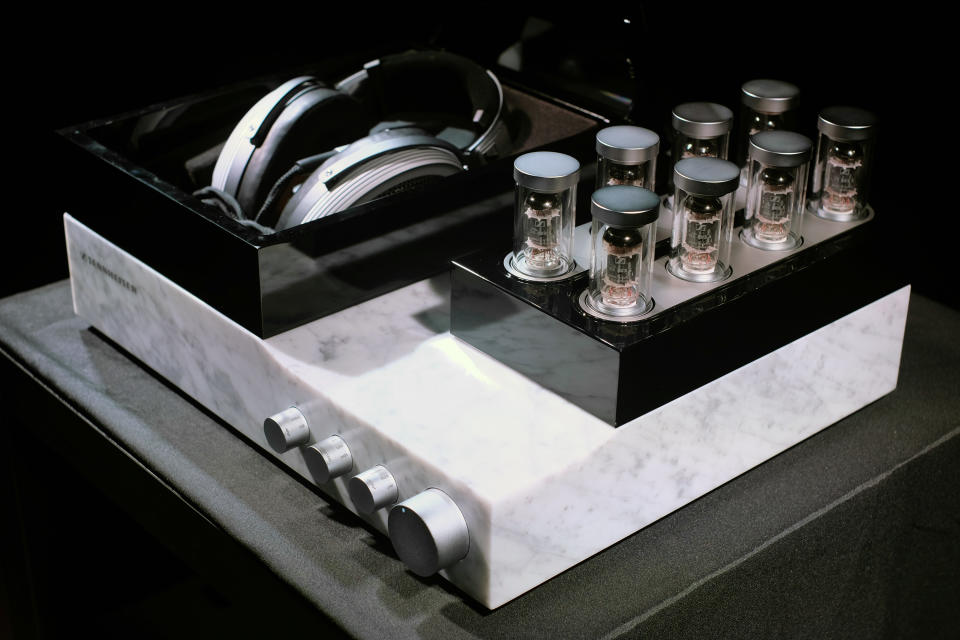I didn't listen to a pair of $55,000 headphones

I was supposed to try out Sennheiser's new Orpheus headphones yesterday. Priced at $55,000 and a decade in the making, they're a reimagining of the company's 1990 model of the same name. But just as I put their opulent band over my head, before even a single note had played, the prototype headphones stopped working. I was crestfallen. But the more I think about it, the more it doesn't matter.
I arrived at a hotel in the center of town, soaked through from the London rain. After speaking with a Sennheiser representative, I shuffled down to the basement to begin my listening experience. Ahead of me lay a barren room. In the center, under the proverbial and literal spotlight, was the Orpheus, flanked by a pair of luxurious armchairs. Nothing else was in the room, apart from the Sennheiser representative and an enthusiastic banner proclaiming the company was "reshaping excellence."
I could write a 1,000-word piece of gadget erotica to explain what happened next, but I'll keep things short. I sat down, stared longingly at the giant Orpheus in front of me, drooled slightly at the T+A media player it was connected to, chose a song, and then sat there patiently for a demo that would never begin. During the wait that followed, I had the opportunity to inspect the Orpheus in detail. It's a stunning piece of hardware; a worthy update to the company's 1990 classic.

This isn't just a pair of headphones. The Orpheus package is a giant marble block with an enclosed headphone compartment on the left and a mysterious smaller box on right. Just turning it on would be enough to drive your inner gadget freak wild. Press the power button, and its four aluminum knobs glide out from their marble sockets, followed by eight vacuum tubes that emerge from the mystery box on the right. Then, the glass lid of the headphone compartment smoothly swings open. The whole process takes around 20 seconds, but that's something Sennheiser has designed for. It's supposed to heighten the anticipation, and make each listening an event.
The cans themselves are beautiful. Mostly aluminum, they're actually fairly light despite their behemoth proportions. The headband is well-cushioned and coated in a luxurious velour, while the earcups are clad in a soft black leather. Like the original Orpheus, these are electrostatic headphones, which means rather than traditional drivers they have an ultra-thin electrically charged diaphragm. I've tried a pair of electrostatic headphones made by Stax, a Japanese company almost synonymous with the category, and they sound fantastically balanced. The reason you don't see them around more often is they're very expensive. Well, that and the fact that because of the high voltages they require to work you can never really use them away from a power supply.

One of Sennheiser's (very helpful and apologetic) representatives attempts to diagnose the prototype Orpheus' issue.
I waited around 45 minutes for Sennheiser to make my day. The staff were extremely apologetic, and worked non-stop to diagnose the issue. The problem seemed to be that either the amp or preamp wasn't detecting that the headphones were plugged in, and so no power was being sent to them. After hushed phone calls with the German engineering team, and many many "turn it off and turn it on" fixes attempted, the representatives conceded defeat, and I packed my bag and left. For what its worth, this shouldn't reflect badly on the company or the headphones. The model in London is a prototype, after all, and it had been used extensively the entire day before my arrival.
On the journey home, I contemplated what to do about the situation. Sennheiser has now fixed the Orpheus -- it was a calibration issue, apparently -- and I've been invited back to listen another time. But I began to think about whether I really need to listen to them. I've inspected the headphones -- which the company readily admits are a statement that it can make the world's best headphones, rather than a product it's particularly serious about selling hundreds of. I've seen how beautiful they look. I've sat, awestruck at the workmanship involved. What more can I tell you?

Truth is, I don't know what anyone can tell you about this pair of headphones after listening to just a couple of tracks. I'm probably slightly ahead of the journalistic curve when it comes to audio products. I've had the pleasure of demoing $5,000 CD players, I've listened to $4,450 headphones -- I have a decent amount of experience with "audiophile" equipment. But I certainly don't have a reference point for what $55,000 should sound like, and I certainly couldn't judge something's worth in 15 minutes.
The new Orpheus are probably among the best headphones ever made. The audible difference between them and a $5,000 pair is probably not huge. Unless my boss suddenly decides to multiply my salary by itself, I'm probably never going to buy these headphones, and neither are you. All we need to know is that they exist. And all we can hope now is that the advancements Sennheiser has made to create them will trickle down to the rest of us over the coming decades.











